The following is a collection of information I’ve learnt about my Hurst family. The page is updated as I find new information and was last updated 26 Feb, 2017.
Featherstone and Mary Ockerby: Tasmania Pioneers by Kathy Wright provided extensive background of the Ockerby life in Yorkshire and early life in Australia.
Thomas Ockerby Hurst
My great grandfather Thomas Ockerby Hurst was born in 1873 in West Yorkshire to Charlotte Ockerby, age 32, and Charles Hurst, age 35. Charles Hurst was the son of a coal porter who came from a farming family near Whitby. He married Charlotte Ockerby in April 1868 when he was 30 years old.
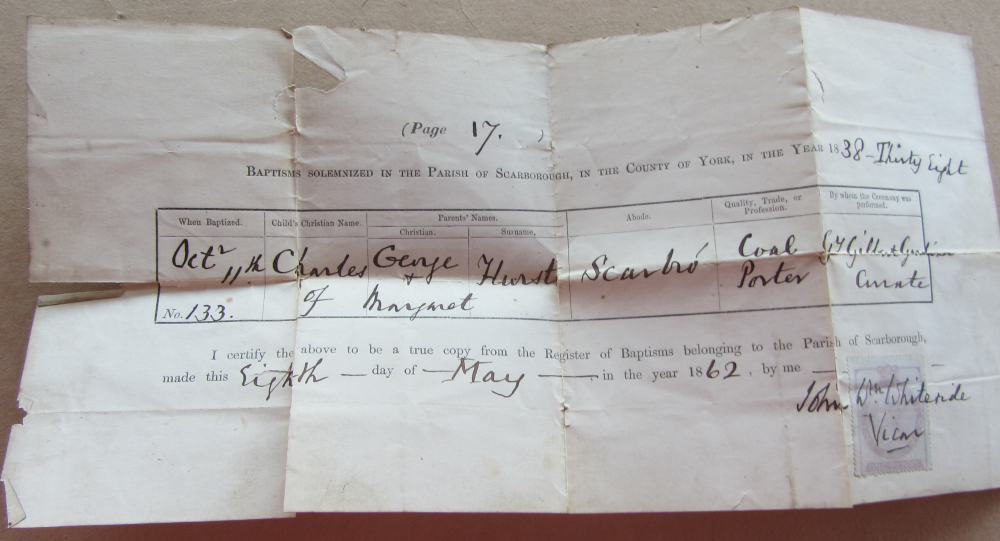
Charlotte’s father, Thomas Ockerby, and her brother, Featherstone Ockerby, owned a transport business in Dewsbury which consisted of carriages, hearses, mourning couches, wedding carriages, riding horses for hire, horse-drawn cabs and horse stables. They ran a service between Dewsbury and Bartley. Featherstone lived for awhile in the house where they had the yard and stables in Bartley.
Charles was originally a ship carpenter and became a grocer after marrying Charlotte. Charles carried on a grocery business at the top of Daisy Hill and later on Church street in Dewsbury.
According to the family tree compiled by Thomas Ockerby Hurst, in 1939, Charles and Charlotte had 5 children. Three of the children died in infancy and his older sister Annie Hurst born in 1971 died of TB in 1889 when she aged 18.
Featherstone Ockbery built a semi-detached house (two dwellings under the same roof) in Dewsbury in 1873 which was known as “The High Close”. Three generations and sixteen of the Ockerby family eventually lived under the same roof in ‘The High Close’ which was four storey high and lite by gas.

Charles and Charlotte Hurst moved into The High Close in 1875 when Annie Hurst was aged 4 and Thomas Ockerby Hurst was 2. By this stage Charles was ill and he died in 1878 of kidney disease at 39.
They shared the left hand side of the house with Charlotte’s parent’s Thomas and Ann Ockerby (nee Featherstone). Featherstone, his wife Mary and their children lived in the right side of the house.
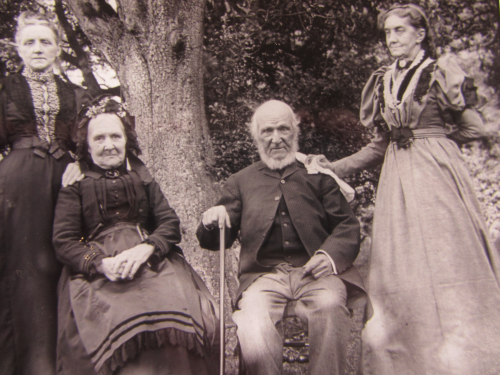
Thomas Ockerby died in 1882, leaving his real estate to his son Featherstone Ockerby and his personal estate to his wife Ann Ockerby to be passed onto Charlotte Hurst and her children on Ann’s death.
Feather Ockerby sold his coaching business in 1887 and emigrated with his wife and children to Tasmania, Australia on the cargo steamer Tiverton on October 20, 1883.
Charlotte Hurst remained in England with her two children and moved with her mum Ann Ockerby into a well built terrace house just behind the High Close at 9 Clarke Street, Anroyd. Her daughter Annie Hurst died of TB in 1889.
Marriage
The inheritance from Thomas Ockerby supported them and enabled Thomas Ockerby Hurst to graduate in a Bachelor of Arts with Honors to become an Anglican priest.

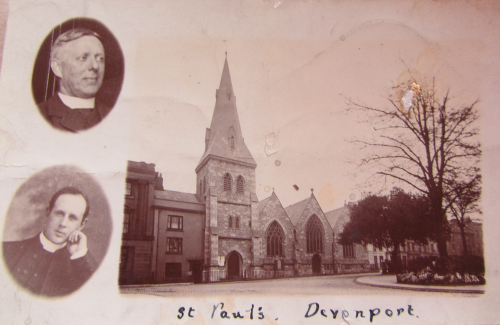
Charlotte stayed in the Clark Street house until Ann died aged 93 in 1904.
Thomas Ockerby Hurst married Mary Anne Hutchinson in 1905. Charlotte moved to Devon to live with them until her death on New Year’s Day 1908 at their home at 6 Brunswick Place, Devonport.

Mary Anne and Thomas Ockerby Hurst were related. Mary Anne and Thomas Ockerby Hurst grandfather were brothers. Charles Ockerby, the brother of Thomas Ockerby, was Mary Anne Hutchinson’s grandfather and Thomas Ockerby was Thomas Ockerby Hurst’s grandfather.
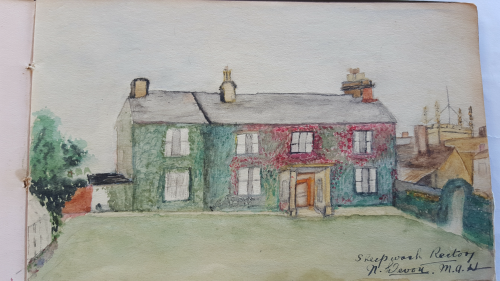

Mary Anne and Thomas Ockerby Hurst had three children:
- Fanny Hurst b 1906 d 2000 m George M Edgecombe b 1902 d 1994
- Charles Herbert Hurst b 1908 d 2006 m 1936 Clarice Emma Hill b July 19, 1903 d 1973 m Mollie
- Sheila Hurst b 1916 d m Web Green
I don’t currently know much about the Hutchinson’s history other than the following sketch that was sent to my great grandfather or grandfather by one of their English relatives.
Migration to Australia
Featherstone Ockerby’s son Thomas Ockerby, who at the time was a successful flour miller in Western Australia, persuaded his cousin Thomas Ockerby Hurst to emigrate while on an English business trip with his wife on 1914.
Thomas Ockerby Hurst and Mary Ann Hurst (nee Hutchinson) emigrated to Western Australia departing March 13, 1914 on the Orient Steamship Company’s Orvieto with my grandfather Charles Herbert Hurst (aged 5) and his sister Fanny Hurst (aged 8).

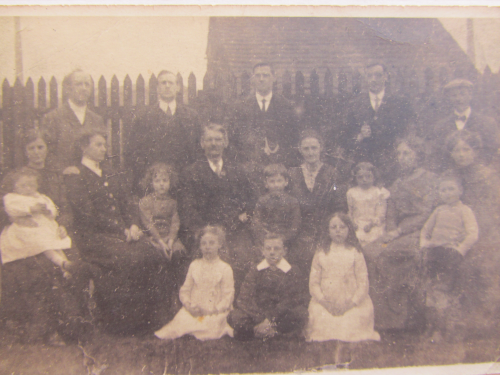
From back row to front:
- Back Row – Thomas Ockerby Hurst, William Hutchinson, Herbert Hutchinson, Charlie Hutchinson, Hamey Goodall
- 2nd Row – Aunt Edith & Alice, Aunt Mollie, Fanny Hurst, George Hanson Hutchinson (granddad), Charles Hurst, Fanny Hutchinson (Granny), Mary (me), my mother, Aunt Eleanor & Arthur
- Front Row – Garnet, George & Dinnie
The ship arrived into Fremantle in May 1914.
The Orvieto was launched in July 6, 1909 and did the passenger service/mail run to Brisbane, Australia. The March 1914 was Orvieto last return trip to Australia before the outbreak of World War I. The Orvieto was requisitioned by the Admiralty as an armed merchant cruiser. She resumed London – Sydney – Brisbane service on Nov 1, 1919.
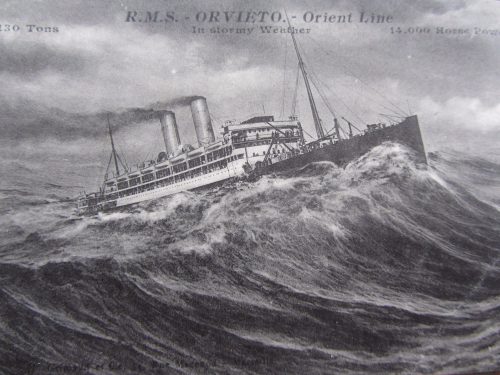
The family lived in the following locations as a result of Thomas Ockerby Hurst work:
- 1914 – 1918: Rector of Harvey Anglican Parish
- 1918 – 1923: St Barnabas Anglican Church, Greenbushes
- 1923- 1925?: temporary appointment at St Albans Church
- 1925 – 1930: Rector of Goolmaling Anglican Parish
- 1930 – 1938: St. Barnabas’s Anglican Church, Kalamunda
- 1938- 1947: St Aidan’s Anglican Church? East Victoria Park
Greenbushes
The family lived in Greensbushes from 1918 to 1923.
St Barnabas Church, built in 1899, is the oldest standing Church in Greenbushes. The following postcard photos are from Thomas Ockerby Hurst’s album and were taken in 1919.
And this is what St Barnabas Church looks like in 2017. The interior of the church is amazing!
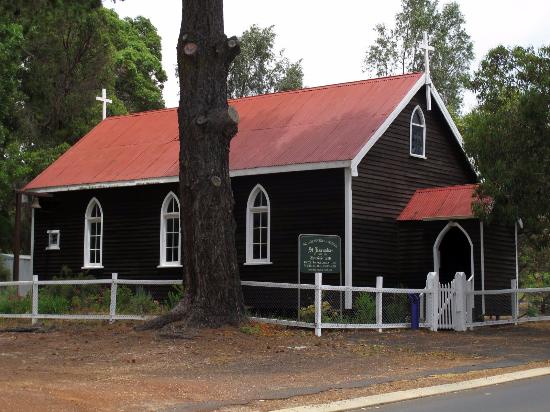
Kalamunda
https://twitter.com/warwickmcarter/status/501344890735718401
Thomas Ockerby
Thomas Ockerby (Featherstone Ockerby’s son) persuaded his cousin Thomas Ockerby Hurst to emigrate while on an English business trip with his wife on 1914. At the time Thomas Ockerby was a successful flour miller in Western Australia.
Thomas Ockerby migrated to Australia with his family when he was fifteen and initially lived in Tasmania. He moved to Perth, Western Australia, with his wife Edith in 1897.
The following article is from 1922 ‘TOM OCKERBY’S STORY.’, The Southern Argus and Wagin-Arthur Express (Perth, WA : 1905 – 1924), 6 January, p. 3. , viewed 09 Dec 2017,
Tom Ockerby’s Story – A Sensational fifteen years
When Thomas Ockerby arrived by the Great Western recently to answer charges of alleged fraud and embezzlement leveled against him in connection with the liquidation of Ockerby and Co, another stage was reached in one of the most sensational and meteoric business careers this State has recorded.
A Rapid Rise.
In 1906 Tom Ockerby commenced operations as a miller and started in a decidedly modest way. He formed a company, and it was capitalised at the comparatively small sum of £4,000.
Fifteen-years later the same business had a turnover of one million pounds sterling, and Tom Ockerby, the miller, was progressing splendidly towards becoming a millionaire.
But even as he entered upon the new year the Fates were, loading the dice against him, and the combination of plucky investing genius and business luck that had brought about his wonderful success in so restricted a sphere and so short a time were to encompass his undoing and bring crashing down the wonderful business structure he had built.
In his own words, if it had not been for the unfortunate purchase of ten thousands tons of second quality flour in Victoria and South Australia during May and June 1920 (which, although it showed a profit of £14,000 during those two months, resulted subsequently in a heavy loss), Ockerby and Company would still be one of the most prosperous milling concerns in Australia, and its chief would not now be returning to bis home city under escort after unsuccessfully fighting extradition in a foreign country
Illness Intervenes.
Perhaps even despite the unlucky deal in Victoria and South Australia the crash would have been averted had not illness stepped in and laid the presiding genius of the business aside. In June, 1920 Tom Ockerby had a nervous breakdown, and did not take an active part in the business for the rest of the year. For months he could not even dictate a letter, and all the vast business of the firm in its most critical hour had to be conducted by his sons or his staff.
It was during a health trip made to Java and Singapore the previous year that the transactions the subject of the present action were made, and when the crash came a year later and the liquidators were appointed the legal procedure followed.
To follow the fortunes of Ockerby: In April last the Company went into voluntary liquidation, and subsequently the head of the firm went to Adelaide and Melbourne. Though stili a sick man he determined to start again. He formulated a scheme for supplying wheat and flour to British firms and planned to leave for London via America to make the necessary arrangements and return to Australia in October or November of this year.
When the Sonoma left for her July trip to San Francisco the name of Thomas Oclcerby figured among the passengers, and those who traveled with him stated that he was popular with the crowd on board and mixed freely with his fellow travelers. The Souoma arrived at San Francisco on July 19, and to the miller’s surprise, immediately she berthed, a United States police officer informed him that he had a warrant for his detention. Explanations Were hopeless. On a charge of alleged fraud and embezzlement the man who nearly became a millionaire was marched from the steamer to the court.
With Murderers and Thieves.
Forthwith he was committed to the county goal and locked up until the following Friday. “My companions in the county goal,” he says, “were many. They were awaiting trial for murder, robbery, abduction, whisky-running, selling prohibited drugs, and all manner of other offences.”
I was placed in what appeared to be a large iron tank,’ he continues, “with bars in front of it. These tanks occupied the whole front of the building, and were in tiers one on top of the other right up to the roof.”
He was brought up again and remanded, and finally a friend from five hundred miles away arrived and bailed him out.
Followed a long legal fight, the result of which was the order by the American authorities that he be extradited. An escort was sent from Western Australia, and by a recent boat the defendant returned accompanied by Detective Dungey. He subsequently entrained for Perth and arrived here, as we stated, on a Sunday. Here the story of the present must stop.
The one bright spot in the whole of the affair for the central figure must have been the manner in which Mr Ockerby’s friends rallied around “him.—”The Call.”
Charles Herbert Hurst
Charles Hurst, my grandfather, was the middle child of Thomas Ockerby and Mary Anne Hurst. Born on 20 July, 1908 in Sheepwash, in Devon and died 23 Feb, 2006 aged 98 years.
Below is a copy of a letter sent by his father to announce his birth:
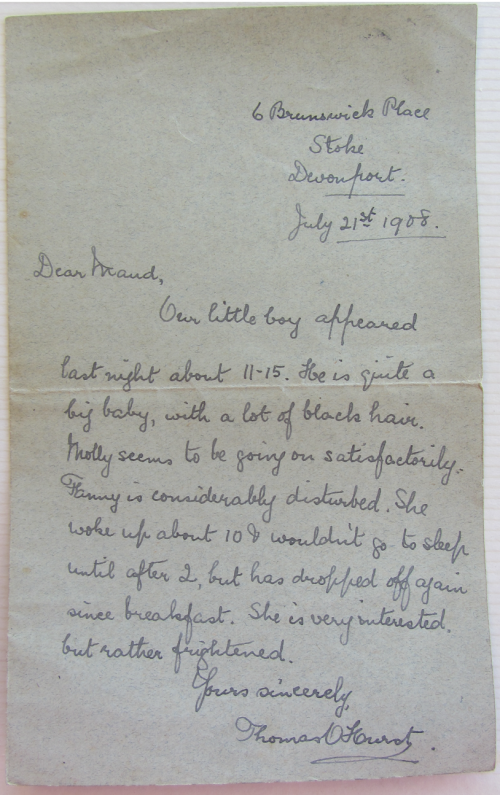
And his baptism:
The following is the eulogy from Charles Hurst’s funeral written by his son Ric Hurst.
Charlie to most but usually Charles to both his first wife, Clarice, and Molly his second. “Boy” to his sisters
Dad or “the ol’ man” or sometimes worse to his two children……usually when his notorious stubbornness, supposedly a Yorkshire trait, drove them to distraction !!!!!
And of course Granddad to the next generation…….despite his wishes to be called anything but by the first batch who couldn’t handle calling their Mum’s Dad “Charlie”.
From their viewpoint….tough if it made him feel old.
There is no doubt that Charlie was never an “old man” in his mind despite his years.
Regardless of where you fitted with Charlie, his willpower and tenacious determination were admired by all.
We all anticipated him getting the telegram from the Queen in 2008.
After losing a farm in the Great Depression, a hand in the ‘40’s to a sawmill, one wife in 1973, a second in 2000, and then a leg to circulation problems in 2003 one could assume that a man would give up, get sour and grumpy, then go into a nursing home to fade away.
Not Charlie….. who fiercely defended his right to live alone and care for himself despite a tin leg, failing eyesight and limited hearing.
More inspiring was the fact of his alertness and sense of humour, and continuing joie de vivre.
Many would see him tearing down the street on his shoprider, a hazard to all……when you can’t see the traffic…….or hear the traffic it can be interesting!
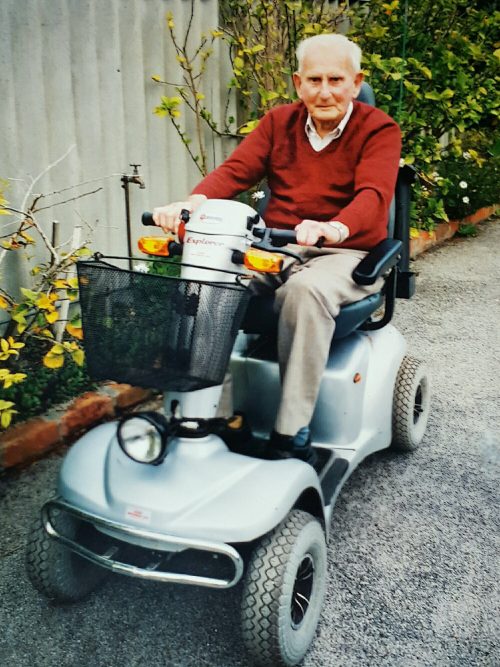
Only the day before his fall he told of practicing on the mouth organ as he was going to the shopping center to buy some flowers and play a few tunes for some of the girls there.
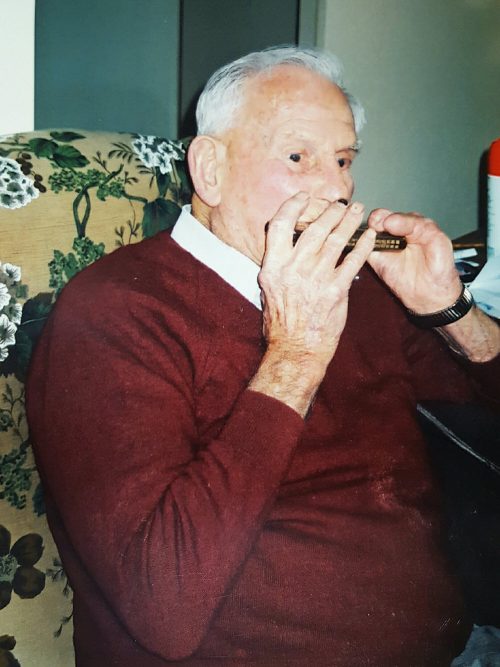
“They are very nice……often come and give me a kiss…………I am buying a lot of flowers lately !!!!!!!!”
Arriving in Australia in 1914 as the son of an Anglican parson, Charlie’s first taste of Australia was as a kid in Harvey.

When the Rev T O Hurst moved to the tin mining town of Greenbushes Charlie experienced the cruelty of the miners’ tough little Aussie bush kids who mercilessly bullied the little pommy boy.
The solution was to toughen up and become a bigger larrikin than the rest of them.
By all accounts this may well have been one of his greatest successes!!!!!
Gone are the days when size 10 coppers boots up the backside and the stern words “I will tell your Father” were enough to make the worst kid quake.
In today’s world it is likely Charlie would have been in juvenile detention.
Modern society is less tolerant of the stealing of mining detonators, the subsequent use as targets for pea rifle and ging as they sat in the holes laboriously hand bored through split fence posts.
I gather the result is further splitting of the post and a collapse of the fence wires!!!
We definitely disapprove of kids unchocking mining skips and riding them down the sloping tracks into slurry flooded mines…….just for a lark and a swim!!!
His unworldly Parson Father had even let him loose with a Stevens “Crackshot” .22 rifle as an eleven year old………despite the prior offence of shooting his older sister in the bum with an air rifle.
The raiding of orchards could not be considered stealing……..just boys being boys!!
All in all, Charlie as a kid may well have qualified, not as a delinquent…….but in this politically correct age…..as a dangerous armed terrorist !!!!!
From Greenbushes State School Charlie was sent to Guildford Grammar where he spent seven years as a boarder.

We are not sure that at 19 years of age he actually passed his Leaving.
We have learnt that his Masters commended his papers but protested that his handwriting was such that they could not properly mark him in the time available.
We do know that he loved history and the classical languages and was awarded prizes for his studies of Languages and Divinity.
That must have been when he wasn’t up to mischief.
Like the occasion when strings to the Master’s table legs resulted in an upturned table and a school master with an upturned inkpot on his head. Said Master’s glasses were certainly not rose-tinted as Charles was viewed through rivulets of black ink cascading over the lenses and dripping from the frames.
Charlie also developed as a fair cricketer and footballer.
It is likely that the tempting watermelons across the Swan may have improved his swimming too.
During those days Parson Hurst was at Wongan or Goomalling and “The Smiling Parson” as he was known became somewhat legendary for his fast trips between services in his “T” Model Ford.
A Father Son competition soon developed as Charlie, on holidays, would achieve better times.
Until his Dad had the whole of the next term to once again set the pace.
It is easy to see that Charlie’s “lead foot” developed early. He often claimed that he would put in his Will that there was a bottle of Scotch for the first to arrive at the cemetery after his church service, as he had no patience for the slow parade from church to grave.
Many a mourning crowd arrived at the grave to find Charlie there before them!!
Unfortunately that detail was overlooked in the Will.
He was also would to state that a funeral was too serious to be taken seriously………and welcomed any joke to ease the somber occasion.
On leaving Guildford Charlie went to the “Wallecup” property of Dr House to work and learn farming.
We believe he practised assiduously at football and beer drinking, driving the ubiquitous T Model on greasy clay roads………… and giving himself a lifetime abhorrence of Port wine!
We all know that feeling !!! It must have been quite a binge !!!!
His unworldly Parson father then set this youth up on a farm on the outskirts of Wongan Hills.
A combination of youthful diversions and the Depression were not long in sending Charlie on the road with nothing but meager possessions on his back and two horses.
Somewhere during this rather lean time in his life Charlie developed his ability as a boxer and we understand went close to becoming professional.
His pugilistic skills added to his confidence and the training mellowed a fiery temper.
After a spell in the Edgecombe vineyards working for his brother-in-law, Don, Charlie obtained a position on the E Day & Co property “Sunnyhurst” at Bridgetown.

Settling into that life he married the principal’s daughter, Miss Clarice Hill and became a partner.

The late ‘30’s saw the arrival of a daughter, Millicent Mary………better known now as Janne.
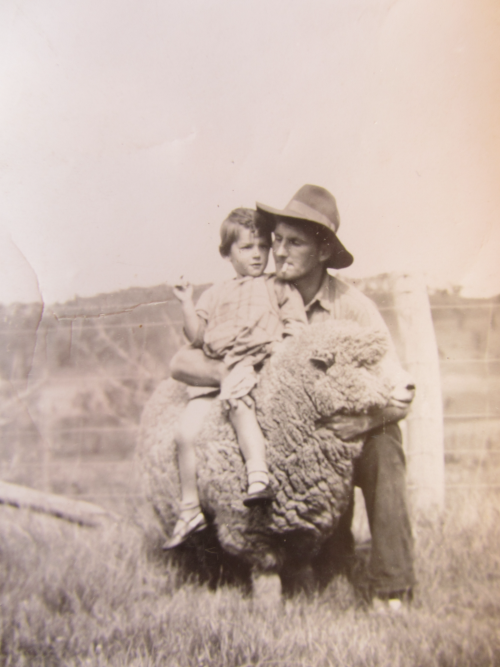
During 1941, whilst manpowered, the loss of most of a hand in a sawmill left Charlie frustrated by an inability to get an active service posting as the War situation deteriorated.
It is notable that despite the disabled hand, Charlie continued with everyday life on a farm.

His family accepted his situation as normal and apart from cufflinks and collar studs he never asked for help because of it.
This ability to cope was an inspiration to disabled youth over the years and his example sometimes provided that extra push others needed to get on with life after disabling injuries.
Help with cufflinks was a routine need as Charlie’s background and interests naturally led him into the Masonic Lodge. After joining in Bridgetown Charlie remained a member throughout his life. Although not active in his latter years Charlie had previously been most involved and had attained Grand Lodge Honours.
In 1944 Clarice added a son to the family, Richard…….better known as Ric.

1947 saw a health crisis for Father-in-law, Ern Hill who decided to sell up and distribute the shares of the partnership within the family.
The Hurst family moved to a leased property west of Pingelly and in 1950 moved again and purchased a property east of Popanyinning.
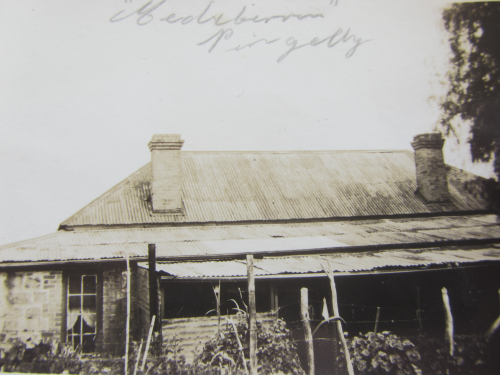
The “Popo” farm was home during Ric’s formative years and there are prized memories of both humour and amazing patience as Charlie was such a pleasure to work with.
What other boy survived, without abuse, driving the crawler tractor and header through a boundary fence on the first round of a new paddock at harvest??
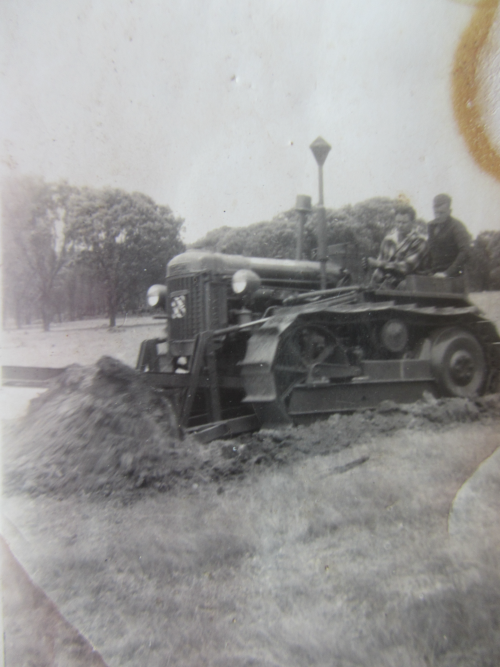
It was easy to pull the wrong lever at only eleven years of age!!!
Imagine the patience to tolerate the youth who comments “It is time like this you need a sense of humour” as you trudge home some miles at sundown after that same youth has bogged not one…but two tractors with his stupidity.
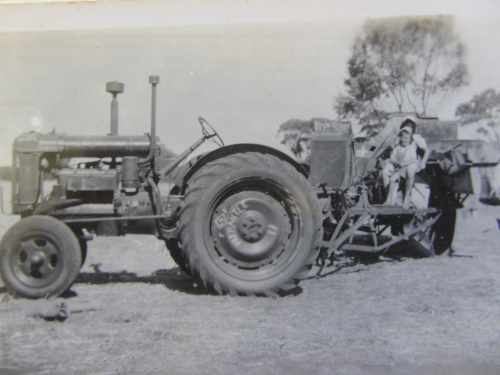
With delight one recalls Millicent, when housekeeping as a 15 year old, running from the dunny screaming “SNAKE”!!! Charlie was never sure of his skills at identifying snakes …so after the .410 had blown a hole in the roof the poor innocent little Carpet Python crawled through to be dispatched.
Young brother will be eternally disappointed that the snake hadn’t just dropped instead of only looking at big Sis.
Dad believed in letting youth find out about drink and cigarettes at home with kindly supervision rather than furtively in less desirable situations. This tolerance led to an ironic situation where Charlie would be driving boys, including School Prefects, back to boarding school whilst one would be happily puffing away with impunity………until he got to school!!
Just prior to selling out at Popo Charlie purchased a harvester at a clearing sale. His blatant larrikinism was still present in 1962 so the unlicensed open tractor was despatched, in the early hours of a frosty August morning, to drive to East Wickepin. Permits?? You jest!!
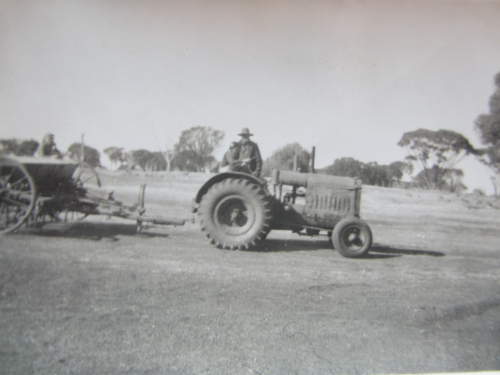
Comb still on, no following escort, car in front with neither signs nor orange lights.. straight through Wickepin, on a busy golf day with fairways across the main road, and to the Popo back roads. A problem…the culvert rails were too high for the comb to clear and the roadways over them too narrow.
Easily fixed when one has a chainsaw in the boot !!!!!!!!!
Clarice had become afflicted by multiple sclerosis and had also never come to terms with leaving her hometown, Bridgetown.
Thus in 1962 the Charlies and Clarice sold out the farm in Popo and returned to a property east of Bridgetown on Tweed Road.
In the late ‘60’s the property was sold to Ric, who was then working up north, and Charlie lived on there in the dual role of carer for Clarice who had become bedridden with the MS and general farmhand / caretaker of the property.
When Clarice became too ill for home nursing Charlie continued his life on the farm but added the routine of twice-weekly visits to the Manjimup Hospital.
Upon the death of Clarice in 1973 Charlie’s Lodge friend, the late Ken Smith, urged him to get out and mix with younger people and live.
At about this time Charlie started casual work around to keep himself busy.
Pruning a neglected pine forest with long handled shears Charlie was, at 65, cutting limbs that a 30 year old could not manage.
This tough, fit, man did a little rouseabout work and left the youth of the team in open mouthed wonderment when two could not cope with the same shearers that Charlie had kept up to working alone.
A spell as a janitor in the Wapet Camp on the Barrow Island oilfield was probably Charlie’s last paid work. He likened Barrow to being in gaol as he got his work done in half a day, found it not to be strenuous, and with no interest in fishing had little to do for the balance of his time.
We hasten to add that, despite his misspent youth, there is no record of Charlie ever having been in the cells!!!
Barrow was a common thread in the extended family with Mollie’s grandson Malcolm, Ric, and later Ric’s stepson Jason all working there.
Another common thread for all of those, and younger Grandson, Matthew, was attendance at Guildford Grammar School.
As a result of Ken Smith’s urging Charlie became active in the Bridgetown Repertory Theater, and was to drive considerable activity within that organisation …….and became President for a time.
In 1980 Ric and his family, farming at Gairdner, needed to sell off the Bridgetown land and it appeared that for a while Charlie could be homeless.
Little did they know that Charlie had re-established contact with a widowed childhood sweetheart from his Greenbushes days !!!
What a delight…….and embarrassment……..to have two 70 year old teenagers !!!
After a trip to England, with his bride, Mollie, Charlie settled into life in Albany.
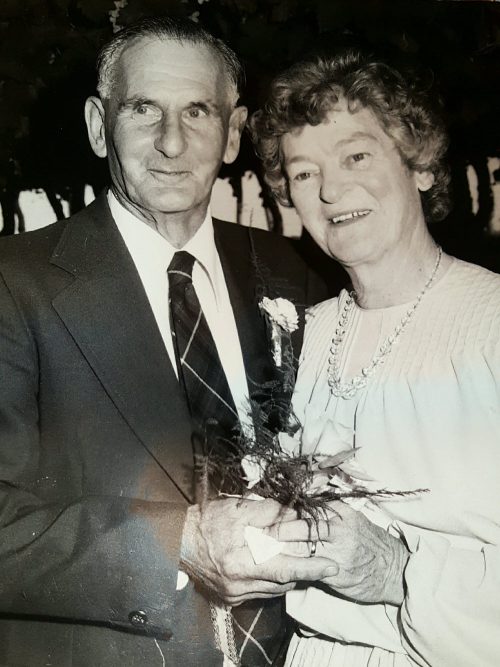
Outside interests saw him involved in the Cemetery Board and the vestry of St Johns…both groups gaining from his love of an argument and his diplomacy.
Charlie resumed a long neglected interest in timber and after attending TAFE took to milling sheoak and turning it into furniture.
Friends and family became recipients of his production, often a little rough, where enthusiasm surpassed both skill and eyesight, and definitely weighty…….usually with as many dovetails as could be used………..along with brass screws to be sure !!!
Article published when he was 80:
Article published when he was 93:
and when he was 95:
His 90th birthday celebrations:
The loss of his leg brought this to a halt….although he would use his saw bench to cut firewood when his shaky one-legged balance prevented an axe being safely used.

During this dangerous time of life in his nineties the sharp mind and ready wit were ever present.
At meeting a couple and after being firmly corrected on his assumptions as to the direction of their friendship he quickly responded to the man “I congratulate you on your taste” and to the lady “and you on your common sense”!!!
It is only a few months ago that he quoted Ecclesiastes Chapter 12 flawlessly to a friend.
One fall too many changed all of that.
We are confident that he would have been quite happy to have passed away with a fall into his saw rather than the slow decline that he endured with anaemia and a hip fracture.
It is certain that the epitaph of his favourite author Gene Rhodes is apt for a man whose passage through life has touched so many of us and left his mark in our hearts.
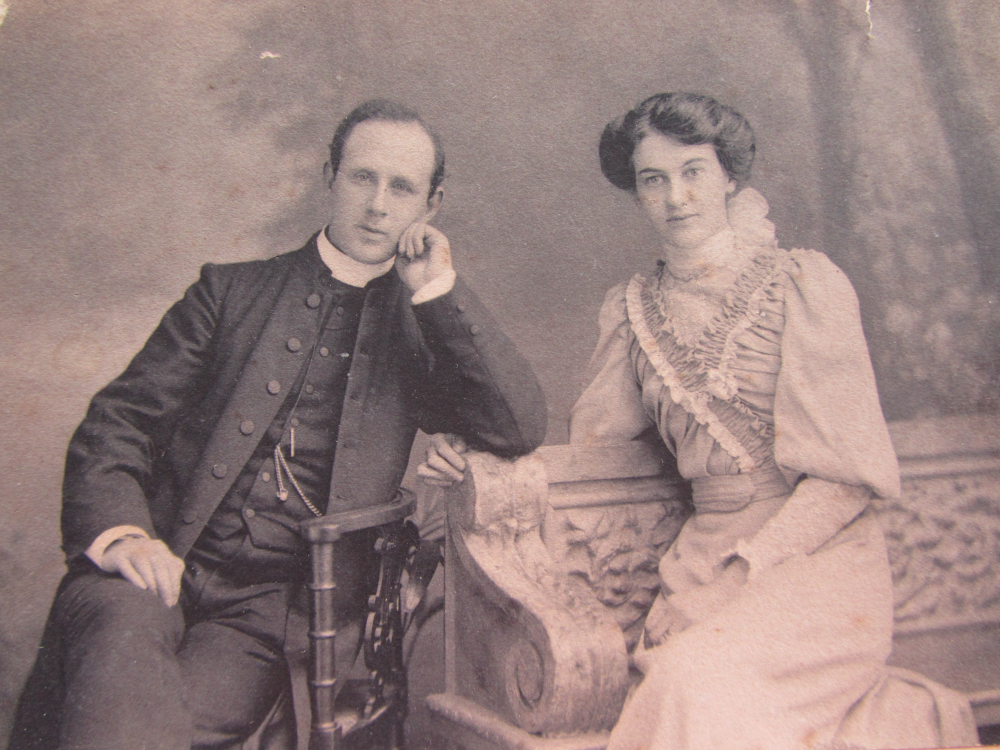
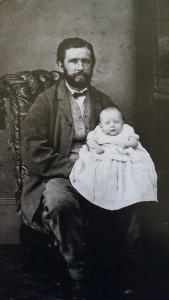
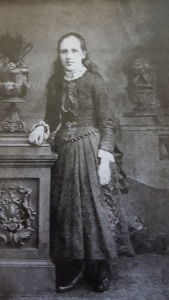
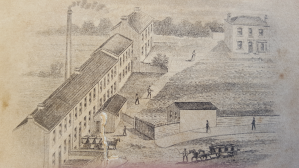
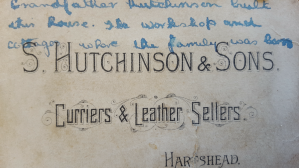
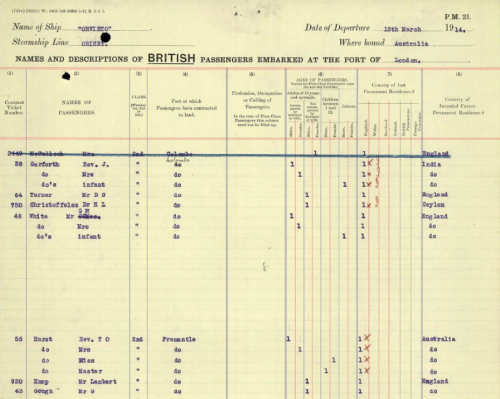


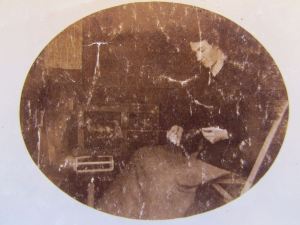

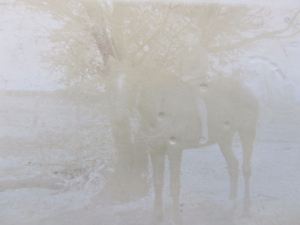



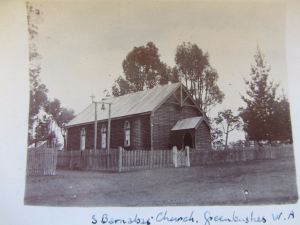

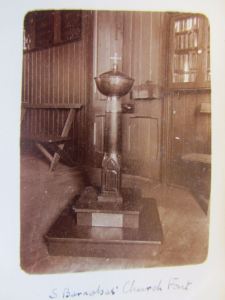

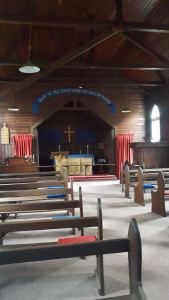



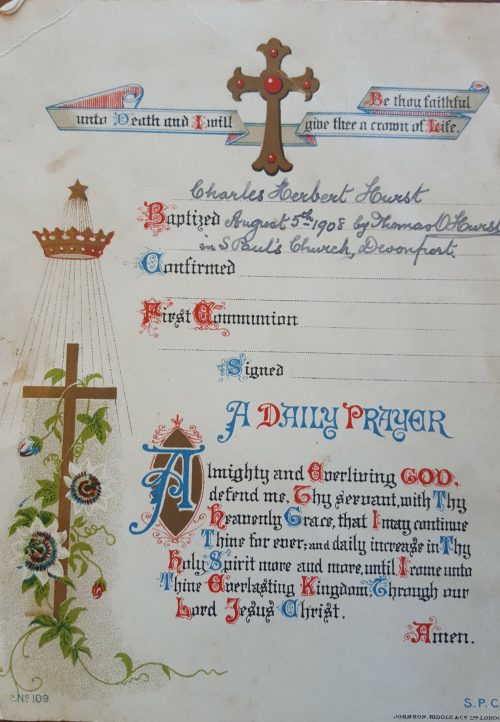
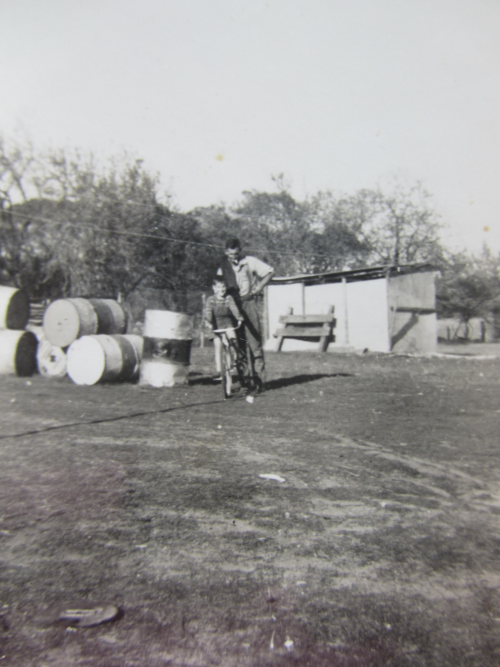


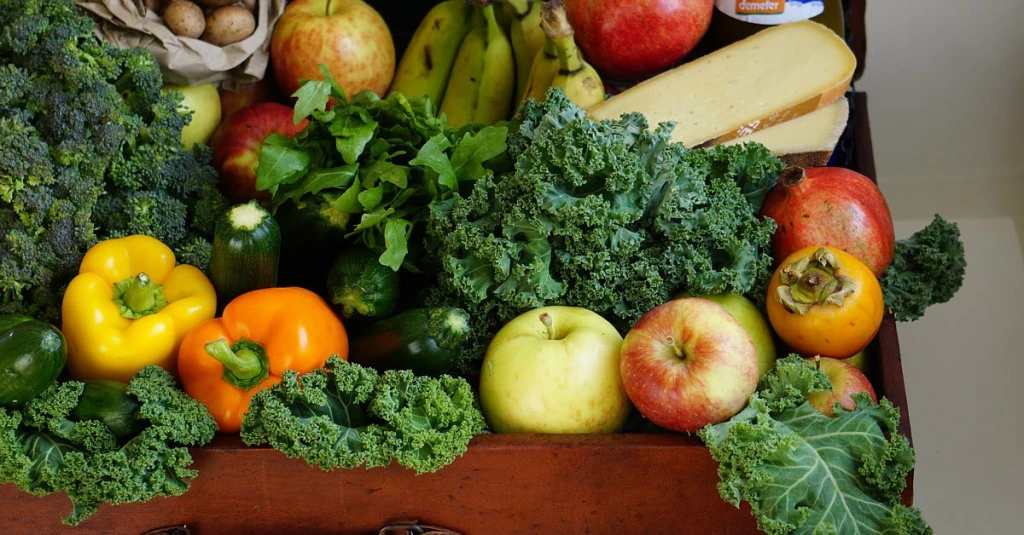
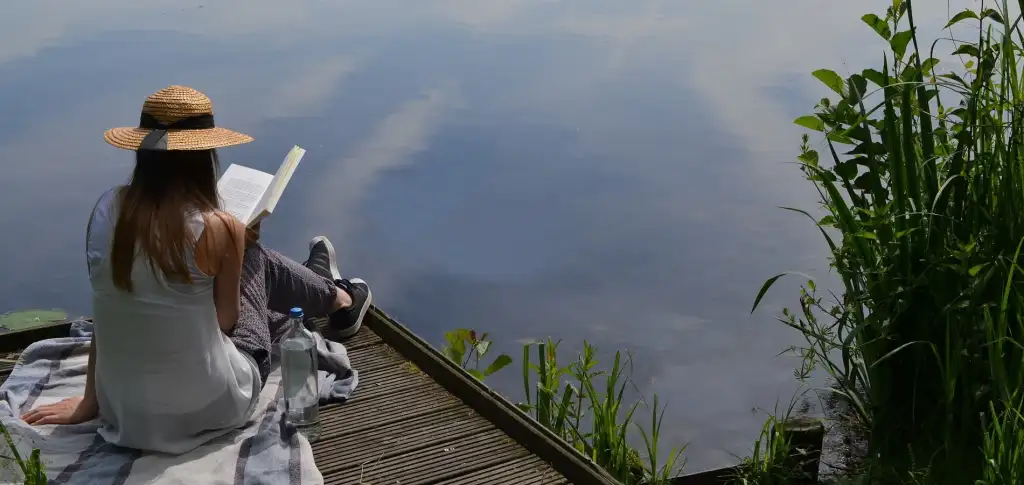
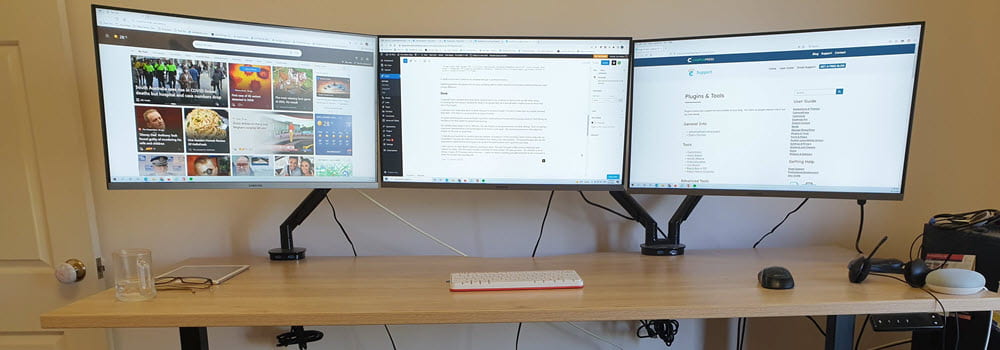
Leave a comment